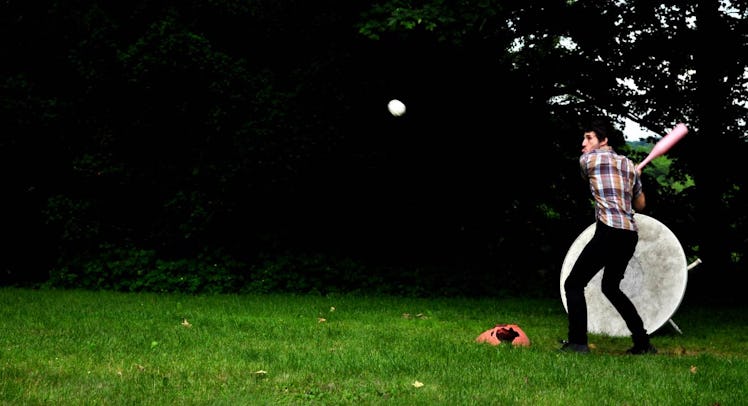The World’s Best Wiffle Baller Explains How To Throw Four Essential Pitches
As explained by the world's best Wiffle baller.

Wiffle ball is one of those sports that casually sneaks up on you, usually when you’ve got a kid or a beer within arm’s reach. Maybe you’re at a barbecue and are suddenly gripped by the urgent need to strike out your neighbor in his own backyard, or maybe your kid wants to learn how to throw nasty stuff like Clayton Kershaw, but you want to do it minus the wrist-snapping, elbow-straining risk of teaching it with a baseball. Whatever the reason, knowing how to make batters look silly is a good summer skill to have up your sleeve.
That’s why we reached out to the only man to see when you have questions about Wiffle ball pitching techniques: Sean Steffy, better known as Wiffleboy in the tight-knit world of organized Wiffle ball. Steffy’s achieved a certain amount of internet celebrity for his pitching talents, not only because he regularly hits 97 mph on the radar gun, but also because his stuff can make great batters look silly at half that speed. The man who once screwballed the Dolce & Gabbana’s right off of Daniel Tosh’s smug face from 48 feet away has 12,000 subscribers to his YouTube channel and a Tommy John scar on his right elbow that testify to his commitment to the sport.
“I get contacts all the time from people, ‘come play on my team’ or ‘come check out my league’ or ‘would you be on our podcast?’” says Steffy, 26. “And it’s fun, I enjoy it.”
To up your backyard game, Steffy offered up four go-to pitches all Wiffle ballers should know. But before you can focus on those, the former college pitcher who now teaches digital media at his alma mater, Mount Aloysius College in Western Pennsylvania, wants to cover some basics.
The Ball: The Wiffle ball is a hollow plastic sphere with eight slotted openings on one of its halves; the other half has no openings. Those openings are vitally important: When you’re ready to throw, know that the ball will break in the same direction that the holes are facing when you release it. Always. “You want all eight holes rotating almost like blades on a fan, perfectly. That movement is what creates the extra speed on the pitch,” says Steffy.
The Basic Grip: The grip for the following four pitches is always the same — a standard baseball fastball grip, with the index and middle finger over top and the thumb on bottom. The Wiffle ball has a hemispheric construction – one half has eight slots in it, the other half has no holes. In each of the below pitches, your index and middle finger should straddle that imaginary line between the two halves of the Wiffle ball. That means that the holes will always face either to the right or the left within that grip. You index and middle fingers should never covering the slots, and they should never be both on the smooth side of the ball.
The Routine: To deliver all four of these pitches you’re taking two grips (holes left, holes right) and combining them with two arm angles (over the top and sidearm) to make four wicked pitches. Note that the motion and grips all assume a right-handed pitcher and batter.
Now, onto the pitches:
Slider
This is your go-to pitch, the most consistent offering and the one that as a beginner you should deliver time and again, says Steffy. “[If] we have to win the tournament, I’m going to tell you to throw you one pitch.” This is that pitch.
- Action: breaks right to left, away from a right-handed batter.
- Arm Angle: over the top.
- Grip: holes should face left, toward the pitcher.
Screwball
This is the inverse of the slider, but harder to master.
- Action: breaks left to right, toward the batter
- Arm Angle: over the top
- Grip: holes should face right, away from the pitcher.
Riser
The most un-baseball of all pitches, this can curve upward as much as 48 inches if thrown properly, says Steffy. It is essentially a Wiffle slider thrown at a 90-degree angle.
- Action: breaks upward
- Arm Angle: thrown sidearm
- Grip: With the sidearm motion, the holes should face up, toward the sky.
The Drop
This is “basically a sinker, or a 12-6 curveball,” Steffy says.
- Action: breaks downward
- Arm Angle: thrown sidearm
- Grip: With the sidearm motion, the holes should face down, toward the ground.
Got all that? Good. Then you’ll have the chance to be a backyard hero. You should know, however, that serious Wiffle ballers do the opposite of everything you just read. That’s because they practice the fine art of scuffing — scoring, scraping, and scarring Wiffle balls for greater control. A scuffed Wiffle ball will behave in exactly the opposite ways as described above. The above directions apply to new and/or unscuffed balls, which Steffy says are much harder to control than a scuffed ball. Depending on who you’re playing with or what league you’re in, scuffing may be allowed. So, for example, a ball thrown overhand, with the holes to the right, instead of being a right-left screwball, becomes a left-right slider. But until the time comes that you start carrying a pocket knife in your equipment bag to rough-up your own balls, you can safely strike out batters with these unscuffed basics.
This article was originally published on